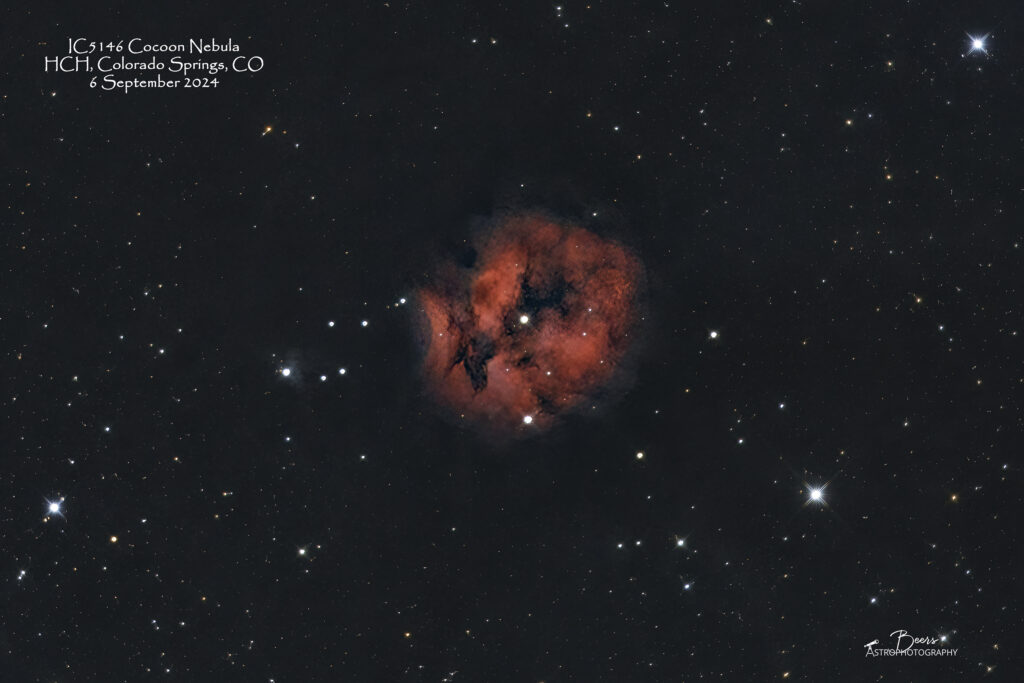
Fun facts
IC 5146 Cocoon Nebula: A reflection/emission nebula and Caldwell object in the constellation Cygnus. The NGC description refers to IC 5146 as a cluster of 9.5 mag stars involved in a bright and dark nebula. The cluster is also known as Collinder 470. It shines at magnitude +10.0/+9.3/+7.2. It is located near the naked-eye star Pi Cygni, the open cluster NGC 7209 in Lacerta, and the bright open cluster M39. The cluster is about 4,000 light years away, and the central star that lights it formed about 100,000 years ago; the nebula is about 12 arcmins across, which is equivalent to a span of 15 light years.
IC 5146 is a stellar nursery where star-formation is ongoing. Observations by both the Spitzer Space Telescope and the Chandra X-ray Observatory have collectively identified hundreds of young stellar objects. Young stars are seen in both the emission nebula, where gas has been ionized by massive young stars, and in the infrared-dark molecular cloud that forms the “tail”. One of the most massive stars in the region is BD +46 3474, a star of class B1 that is an estimated 14±4 times the mass of the sun. Another interesting star in the nebula is BD +46 3471, which is an example of a HAeBe star, an intermediate mass star with strong emission lines in its spectrum.
Other Catalog Designations: Caldwell 19, IC 5146, SH 2-125, LBN 424, Barnard 168, Cr 470, Ced 198, Cocoon Nebula
Subtype: Cluster associated with nebulosity
Distance from Earth: 6500 light years; 1986 pc
Apparent Size: 12’
Size: 15 light years (diameter)
Magnitude: 7.20
Constellation: Cygnus
{Target information derived from: https://en.wikipedia.org/wiki/IC_5146 and Stellarium}
Capture & Processing Notes
Another clear night with very little moon to verify the EAF performance with Big Zeus. My original plan was to image the SH2-101 Tulip Nebula from dark until it set at about 03:00MDT, then image M52 the Cassiopeia Salt and Pepper Cluster. But then I remembered I wanted to image IC5146 Cocoon Nebula with Big Zeus – so I switched to that plan for the entire night.
The EAF worked very well with a step size of 175, 9 steps. Although the middle seven steps seem to produce a better result, with the hyperbola that is formed stretching out and moving up in HFR value to match the first and last point in the series. So, the next time I image I may experiment with 7 steps at a step size of 175 to see how that works.
But, in the vain of “it’s always something” – the autoguider decided not to work reliably throughout the night. It would connect fine, conduct the calibration at the beginning of each sequence, pause during auto-focus (while I was watching it), and resume. But it stopped unexpectedly during the sequence – first at about an hour into the sequence (that I discovered when I went out at midnight to conduct the meridian flip – two hours later!). Second, about two hours into the sequence after the meridian flip. Both times the error message in PHD2 stated “ASCOM driver disconnected, check cabling or driver.” All the cabling was fine and still attached. Originally, I thought it was because the cable was too short and with all the cabling in a bundle, a straining may have pulled on the cabling to cause it to electrically disconnect causing the autoguider to fail.
Then after looking at the timing of the disconnect, I’m beginning to wonder if it had to do with the pause during auto-focus that it couldn’t recover from. I haven’t taken the time to look through the SGP log to see what kind of error messages preceded the failure. Imaging capture was: 21:06 – 22:12 (5 minute exposures); 00:16 – 02:14 (3-minute exposures); and 03:36 – 05:21 (when I terminated the sequence for astronomical twilight end).
Sequence Plan (6Aug2024): Gain: 158, Temp: -0°C, offset=30. 11x5min + 68x3min. Captured 6Sep2024, 21:06MDT – 7Sep2024, 05:21MDT. Although there was an elapsed time of 8:15hrs, the total exposure time was: 259min, 4:19hrs due to the issues with the autoguider shutting down the sequence twice during the night.
Processing: Captured in SGP, stacked in APP (Adaptive Airy Disc), star removal with Starnet++, processing with LR/PS
Equipment
All equipment controlled by HP Probook (DSO CTRL 2) Windows 10 laptop running Sequence Generator Pro vv4.4.1.1413..
- Imaging (ASI2400-BZ-LPro): ZWO ASI2400MC imaging camera on (Big Zeus) Orion 10″ f/8 Ritchey-Chretien Astrograph Telescope, Teleskop Service Flattener 1.0x for RC Telescopes (TS-RCFLAT2), Optolong L-Pro LP filter (LPro)
- Autofocuser: ZWO EAF Electronic Automatic Focuser (EAF-5V-STD)
- Mount: Rainbow Astro RST-300 (controlled by iHubo ASCOM driver)
- Polar alignment: QHYCCD camera (controlled by Polemaster for polar alignment)
- Autoguiding: Orion 60mm Multi-Use Guide Scope with Orion StarShoot AutoGuider Pro Mono Astrophotography Camera (controlled by PHD2)onic Automatic Focuser)
Summary
Captured: 1 September 2024, from HCH Colorado Springs, Colorado (259min, 4:19hrs imaging time)
Equipment: Big Zeus, LPro filter, ZWO EAF, Rainbow Astro RST-300
Processed: Captured in SGP, stacked in APP, star removal in Starnet++, processed in LR/PS
